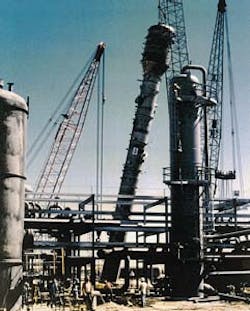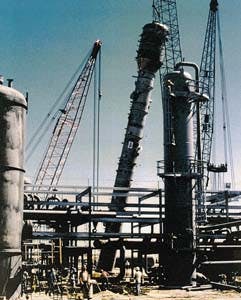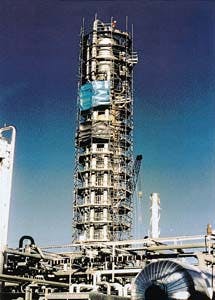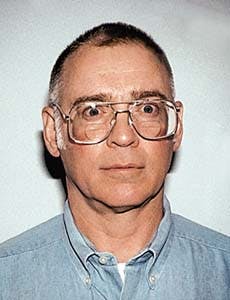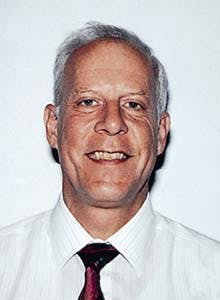TECHNOLOGY
Large U.S. liquids plant starts up
Paul B. Milios
El Paso Field Services
HoustonRichard A. Harris
ABB Randall
Houston
The demethanizer for the 400-MMcfd train is installed (Fig. 3).
The demethanizer for the 400-MMcfd train is insulated after being piped up (Fig. 4).Operation began in 1996 on the new Chaco liquids-extraction plant in northwest New Mexico. The plant's extraction capacity-50,000 b/d of NGLs from 600 MMcfd of gas-exceeds that of any other turboexpander plant in the lower 48 states.
Regulatory reform made the project possible. And significant regulatory, economic, environmental, technical, and logistic challenges were overcome to achieve plant start-up.
Operator El Paso Field Services, Houston, believes the new Chaco plant creates added value when compared to the lean-oil extraction plant which El Paso had operated at the San Juan basin site since the 1950s.
Success of the project was based, in part, on the following:
- Creation of a free-market company by the spindown of El Paso Field Services (EPFS) from El Paso Natural Gas (EPNG)
- Establishment of agreements with producers behind the plant to share the benefits generated by the plant in exchange for acreage dedication
- Negotiation of an agreement with Mid-America Pipeline Co. to expand its pipeline system to receive and deliver to market liquids from the new plant
- Selection of ABB Randall which committed to engineer, procure for, and construct the plant at a cost which provided an adequate rate of return.
Fig. 1 [55125 bytes] shows the Chaco site, old and new plants; Fig. 2 [33159 bytes] depicts the configuration of the original lean-oil plant and the new cryogenic plant.
Project roots
Four conditions were necessary for the project to proceed; failure of any one would have killed it.
Activity within EPNG and/or EPFS' regulatory, marketing, environmental, and engineering departments proceeded concurrently with the expectation that each of the four issues would be satisfactorily resolved.
Unit spindown
Often over the past two decades EPNG evaluated but rejected replacing the Chaco lean-oil plant with a cryogenic plant.
The underlying reason for that conclusion was that EPNG was regulated by the U.S. Federal Energy Regulatory Agency (FERC). As such, disposition of economic benefits that such a plant would create were restricted and directed by FERC.
For example, a percent-of-proceeds arrangement, a rate structure which aligns processor and producer interests, was not allowed.
The reordering of the gas business was precipitated by FERC Order 636 and led to unbundling of pipeline services and "light-handed regulation" of gathering and processing services.
This order afforded the opportunity to spindown EPFS from EPNG. This action was a necessary first step to implementing the Chaco cryogenic plant project.
Spindown officially occurred Jan. 1, 1996.
Producers' agreements
The investment required to engineer, construct, and start-up the new plant was sufficiently large that certainty of gas supply was necessary to proceed with the project.
Agreements were struck with scores of producers for EPFS to process their gas in the new plant in exchange for dedication of their gas to the plant and for other considerations including a percent of proceeds arrangement.
Provisions of these agreements replaced pre-existing FERC-regulated tariffs and represent a more economically efficient way to allocate costs and rewards.
Mid-America agreement
The pre-existing Chaco lean-oil plant was incapable of recovering ethane and was recovering only 10-15,000 b/d of propane-plus liquids. The only viable liquids pipeline out of Chaco connected 80 miles south of Chaco to Wingate, a fractionation plant incapable of fractionating ethane.
The new cryogenic plant was designed to recover up to 27,000 b/d of ethane contained in a total product stream of up to 50,000 b/d. The principal market for ethane is 1,000 miles away on the Texas coast of the Gulf of Mexico.
Clearly, a secure products-pipeline link connected to the ethane market had to be established.
Mid-America Pipeline serves the Four Corners area (New Mexico, Arizona, Nevada, and Colorado) with a major pipeline that runs within 11 miles of Chaco and connects to ethane markets on the gulf coast and Midcontinent U.S.
But Mid-America Pipeline's system required significant expansion to be able to handle the potential liquids that Chaco represented and at a cost comparable to the cost of the Chaco cryogenic plant.
A "chicken and egg" situation: EPFS could not build a high ethane-recovery plant unless Mid-America Pipeline expanded its pipeline system; Mid-America Pipeline could not expand its pipeline unless EPFS built a high ethane-recovery plant.
Resolution was reached in an agreement that bound each party to complete its respective project by a certain date, with significant penalties for failure to comply. Both projects were completed well within the agreed-upon time frame.
Randall selected
Preliminary economic studies of the project identified a capital cost range for project viability.
As no cryogenic plants approaching the size range contemplated had been built for several years, firm cost data were lacking.
A request for proposals asked for a lump-sum price for design, procurement, construction, and start-up of a 400 MMcfd plant. The request specified only plant duty and allowed the contractor to propose the process design.
Economic criteria were provided in the duty specification to allow the contractor to optimize the process design. Preliminary environmental analyses had identified certain emission limits that could be created as a result of the project.
These, when coupled with results from preliminary process studies, identified preferred or limiting drivers for the recompressors and refrigeration compressors. These constraints were included in the duty spec.
Competitive proposals were received from five contractors. Each proposed process design differed from the others, and all were viable and attractive.
Differences in product-recovery levels and utility consumption were evaluated with the economic criteria contained in the request for proposal.
Based upon an analysis of total project capital and continuing operating costs, EPFS decided to proceed with the project, and Randall was selected as the project contractor.
Project execution
Once the four root issues were on track toward satisfactory resolution, the focus turned toward execution of the project.
The project was unique in many respects and typical in others.
It was unique in that the process design features highly integrated systems to maximize plant efficiency and that what started as a 400-MMcfd project grew to a 600-MMcfd project.
It was typical in that, like all major projects, once management finally decides to proceed, the project needs to be completed immediately. It was also typical in that environmental considerations had a major impact on the project.
Following is a project description.
Process design
The plant is designed to recover 93.5% of the ethane and 100% of the propane-plus from 600 MMcfd of 3.6-gpm inlet gas.
It is capable of delivering 50,000 b/d of y-grade product to Mid-America Pipeline, or 10,500 b/d of propane-plus to Wingate and 39,500 b/d of y-grade to Mid-America Pipeline, or any combination of these.
The plant can also reject ethane into the residue, recovering just 12% of the ethane as liquid while still recovering 97.4% of the propane.
The process scheme produced maximum ethane recovery while minimizing the compressor-horsepower requirements for the plant. Because the most significant utility cost for cryogenic plants is fuel for compression, this design offered the most economical solution for minimizing operating costs.
Major sections of the plant include inlet-gas filtration, mole-sieve dehydration, the cryogenic sections composed of aluminum plate-fin exchangers, turboexpanders, and demethanizers, recompression, refrigeration, a deethanizer, product handling including amine treating, mole-sieve drying, and pumping, a hot-oil system, a cold drain system, and a flare system.
The plant is controlled by programmable logic controllers which communicate with a supervisory software program (Intellution) on a Windows NT platform.
Cryogenic plants, by their very nature, are highly integrated from the perspective of heat recovery, or better, "cold recovery."
The Chaco plant goes beyond the normal "cold recovery" and recovers heat from the recompressor turbine exhaust to reboil plant columns and regenerate the mole-sieve beds. This also provides the added benefit of no additional plant emissions.
Equipment changes
Without emission off-sets, the project would have required a Prevention of Significant Deterioration (PSD) permit from the U.S. Environmental Protection Agency. Obtaining it is time consuming, expensive, and uncertain.
In addition, the project triggered application of certain state ambient-air regulations. The response to these constraints was to make equipment changes to the existing Chaco pipeline compressor station, located at the cryogenic plant site, to off-set the emissions expected from the new cryogenic plant and to ensure compliance with the ambient air standards.
The ultimate net impact of the project on the environment was to improve air quality, with a reduction in total potential NOx emissions of approximately 9%.
In order to achieve this level, each existing emission source at the plant was tested to quantify its emission rate, and a weather tower was installed to measure ambient air quality.
Certain assumptions were made concerning emissions from the new plant, as discussed presently. Based upon this information, the following modifications were done in the existing plant:
- Two 3,500-hp Cooper GMWC-10 integral compressor units were retired from service and replaced with new low-emission Caterpillar 3616 compressor units.
- Two 1,800-hp Cooper GMVC-10 units were retrofit with new "clean burn" combustion-ignition components and exhaust stacks on seven others were extended.
- Three 3,400-hp Clark TLA-10 units were retrofit with new ignition systems, and a CO catalytic converter was installed on the exhaust of one of them.
In addition to these modifications, two 440-hp Ingersoll-Rand SVGS-8 recompressors and a 58-MMBTU/hr rich oil heater were shut down as a result of the abandonment of the existing "A" gasoline plant.
The off-sets avoided PSD-permit treatment but did not keep environmental permitting off the project critical path.
Preliminary studies and ambient-air modeling took some 6 months before preparation of a permit application could begin. The permit application took 2 months to prepare.
The state then required more than 7 months to review, obtain public comments, convey, and resolve public comments, process revisions to the application, and obtain authorizing signatures. Construction could not begin until a permit to construct was issued by New Mexico.
Defining compression
Nearly all the emissions from the new plant come from the recompressor and refrigeration driver.
Because the off-sets to avoid PSD treatment had to be defined in the permit application, the likely drivers had to be determined for the permit application months before the process design was known.
Lead time on procurement of the drivers also dictated that they be identified early in the project.
Preliminary process studies which indicated that two Solar Mars turbines would be a good fit as recompressor drivers and that refrigeration-compression needs could be met by the horsepower available from two Solar Taurus turbines, or less.
Based upon these studies, the prepared permit application used two 15,000-hp (ISO) Solar Mars turbines for recompression and two 7,000-hp (ISO) Solar Taurus turbines for refrigeration.
To maintain project continuity, the duty specification contained in the request for proposal required that Mars units be used for recompression and that emissions from the refrigeration units proposed by the contractor could not exceed those of the Taurus units.
This provided the contractor the opportunity to optimize his process design even though the permit application for the project had long since been submitted to the state. It also allowed that the Mars units could be ordered by El Paso immediately upon selection of the contractor, thereby expediting the project schedule.
The optimized design proposed by Randall included two 2,000-hp refrigeration compressors driven by Caterpillar 3608 engines. These engines emit less than the Taurus turbines.
This is what was ultimately selected.
Change management
Just as basic engineering was being completed, the scope of the project changed from a 400-MMcfd plant to a 600-MMcfd plant. This change was paralleled by numerous other modifications including the addition of product drying.
Sorting out the most economical approach to expanding the plant with minimal delay of the project became a major execution challenge. In fact, maintaining project schedule while managing change continued to challenge throughout the project.
Numerous studies with subsequent cost estimates were initiated to determine which sections of the plant should be increased in size by 50% as opposed to adding a complete 50% parallel train. Decisions were also guided by equipment deliveries and operational flexibility considerations.
The magnitude of this activity was reflected by some 80 estimates of change going through Randall's estimating department requiring quick answers so as not to impede ongoing progress.
At this stage of the project it was too late to make changes in the cryogenic section of the plant (high-pressure flash vessel, turboexpander, demethanizer, and plate-fin exchangers) because these long-delivery components had already been purchased.
This section of the plant was left unchanged and a parallel 200-MMcfd cryogenic section added to the project; it would lag the 400-MMcfd train by 2 months.
A third recompressor, a third refrigeration compressor, and a fourth gas-dehydration vessel were also added to the project as part of the second phase.
The remaining sections of the plant (inlet-gas filtration, deethanizer, product handling, hot-oil system, etc.) were scaled up in size and remained a single train.
Construction
Critical path on the 200-MMcfd second phase was again set by environmental permitting.
This dependency had a "domino effect" which handicapped construction activity. Isolated parts of the first train could be installed, while complementary parts of the second train could not be until the second environmental permit was approved.
Items falling into this category were the third recompressor with associated waste-heat units, the third refrigeration compressor, and the fourth gas dehydrator.
These items were installed later in the execution plan at the expense of reduced productivity associated with working around the first-train components which were in the process of being commissioned.
Field manhours were increased by 45% to accommodate project changes and additions, excluding the separate 200-MMcfd train, which accounted for an additional 33% increase.
Project schedule was maintained by expanding the work week to six 12-hr days. In addition, Sunday was used as a makeup day as required.
Despite the accelerated work schedule, construction was completed with an excellent safety record. Beginning of the 400-MMcfd train start-up was delayed only 3 weeks from the preproject expansion schedule, and start-up of the 200-MMcfd train followed by 2 months.
Fig. 3 and Fig. 4 illustrate project execution.
Start-up
Start-up engineers today face a challenge of reconfiguring computer control systems to take advantage of last-minute good ideas for controlling and monitoring a plant. This was also the case at Chaco.
Of paramount consideration, however, was safe commissioning of the 400-MMcfd train while construction continued on the 200-MMcfd train. This required particularly close coordination and planning of start-up and construction around the compressor as well as other areas of the plant.
The 400-MMcfd section of the plant came on line in first quarter 1996; the 200-MMcfd section in the second quarter. Start-up was not without numerous and troublesome challenges including turboexpander modifications, electric motor failures, control-system glitches, block valve and safety valve leaks, and the general need to learn the idiosyncrasies and limitations of the plant equipment and control system.
Following resolution, full production capability was achieved in third quarter 1996. The product recoveries guaranteed by Randall were demonstrated in a plant performance test conducted in October 1996.
Based on a presentation to the 76th Annual Convention of the Gas Processors Association, Mar. 10-12, 1997, San Antonio.
The Authors
Paul B. Milios is a consulting engineer in the commercial support division of El Paso Field Services, Houston. He has worked for El Paso Energy companies for 24 years in various positions in the engineering, operations, and environmental departments. Prior to that he was a process engineer at Esso Research & Engineering Co.Milios holds a BS (1965) from Purdue University and an MS (1967) from the University of California at Berkeley, both degrees in chemical engineering. He is a registered professional engineer in Texas and a member of AIChE.
Richard A. Harris is currently vice-president for project development with ABB Randall Corp., Houston. Over the past 22 years with ABB Randall, he has held positions as senior process engineer, manager of process engineering, project manager, project director, and vice-president-project execution. Harris holds a BS from Purdue University and an MS from the University of Michigan, both degrees in chemical engineering. He is a registered professional engineer in Texas.
Copyright 1997 Oil & Gas Journal. All Rights Reserved.
